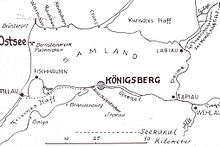Friedrichsgraben (Canal)
The Friedrichsgraben system is a canal system on the east coast of the Curonian Lagoon in what is now Russia 's Kaliningrad Oblast . It connects the Deime with the Gilge and thus creates a connection from the Pregel to the Memel .
history
In 1671 Philippe de la Chièze was contracted by the Great Elector to build a canal connection between the Gilge and the Deime. After his death in 1673, his wife, Katharina de la Chièze (1650–1703), continued the work that had been started. After remarrying, also known as Katharina Truchseß zu Waldburg, she received the right to levy a canal tariff for her efforts. In 1710 the canal became state property. On March 15, 1753, the Prussian government issued a current regulation for shipping on the two Friedrichsgräben. After this had proven to be inadequate in the course of time, a stricter electricity regulation was put into effect on April 14, 1806.
Parts

This canal system improved the infrastructure by opening up the Elk Lowlands and the Großer Moosbruch . It also stimulated trade between Koenigsberg and Russia as well as Poland . The Friedrichsgraben system is divided into:
- Kleine Friedrichsgraben ( Russian Nemoninski kanal )
- Great Friedrichsgraben (Russian Polesski kanal )
- Seckenburger Kanal (Russian Primorski Kanal )
Little Friedrichsgraben
- 55 ° 3 ′ 52.1 ″ N , 21 ° 22 ′ 38.5 ″ E (north) to 54 ° 59 ′ 06 ″ N, 21 ° 20 ′ 40 ″ E (south)
This first section was built in eight years from 1675 to 1683. The canal connected the Gilge at Kryszahnen with the Nemonien (Russian Nemonin ) in its six-kilometer course . Today it is separated from the Gilge at its northern end, interrupted by an approximately 100 m wide dam.
Great Friedrichsgraben
- 54 ° 58 ′ 49 ″ N , 21 ° 17 ′ 17.1 ″ E (north) to 54 ° 51 ′ 55 ″ N, 21 ° 06 ′ 50 ″ E (south)
The 19-kilometer-long Große Friedrichsgraben, built between 1689 and 1697, was connected to the nemons, which were also previously called Wiepe, further downstream to the left. Orienting itself on the coastline of the Curonian Lagoon , it leads in a south-westerly direction to the Deime near Labiau . Created for shipping, it should aim to escape the rigors of the weather on the (open) Curonian Lagoon.
Seckenburg Canal
- 55 ° 1 ′ 29 ″ N , 21 ° 18 ′ 8.3 ″ E (north) to 54 ° 58 ′ 51 ″ N, 21 ° 17 ′ 19 ″ E (south)
Begun in 1833, the Seckenburg Canal between the Gilge near Marienbruch (Russian: Saschenzy) and the Nemonien near the village of Nemonien was completed in 1835 under the direction of the Prussian building councilor Georg Steenke according to plans by the dike inspector Johann Samuel Lilienthal (1724–1799). In practice, the five-kilometer-long canal replaced the Kleiner Friedrichsgraben, which was now superfluous and was therefore dammed. Coming from the Gilge via the Seckenburg Canal, the Nemonien was only crossed (approx. 75 m) in order to be able to drive immediately into the Großer Friedrichsgraben in the direction of Labiau.
literature
- Johann Christian Wutzke : Remarks on the origin and present condition of the Great and Small Friedrichsgraben, and the navigability of the Deime River, as part of the great trade waterway from Königsberg to Poland and Russia . In: Prussian provincial sheets . Vol. 6, Koenigsberg 1831, pp. 549-561 ; Vol. 7, Königsberg 1832, pp. 24-49 and pp. 236-245.
- Johann Christian Wutzke: Remarks on the Litthauische Niederung, which run through the same running watercourses, which partly form the great waterway from Konigsberg to Poland and Russia, and on the creation and maintenance of the dikes of the rivers to protect the lowlands from floods . In: Prussian provincial sheets . Vol. 6, Königsberg 1831, pp. 28-61 and pp. 216-239.
- Christian Friedrich Reusch : News about Countess Luise Katharine Truchseß zu Waldburg, connected with the history of the canals that form the waterways from the Memel to the Pregel. With a portrait of Countess Truchseß zu Waldburg and a map of the canals . In: Contributions to the customer of Prussia , Vol. 4, Königsberg 1821, pp. 249–293.
- August Eduard Preuss : Prussian country and folklore or description of Prussia. A manual for primary school teachers in the province of Prussia, as well as for all friends of the fatherland . Bornträger Brothers, Königsberg 1835, pp. 43–48.
- Hans-Peter Kosack : Geography of East Prussia . Holzer 1952.
Individual evidence
- ↑ von Hagen: The Prussian River Shipping; a systematically ordered compilation of all related legal provisions and decrees . Stettin 1857, pp. 135-143.
- ^ H. Lullies: Geography of East and West Prussia . European History Publishing House, Paderborn 2011, ISBN 978-3-86382-439-6 , p. 12.
